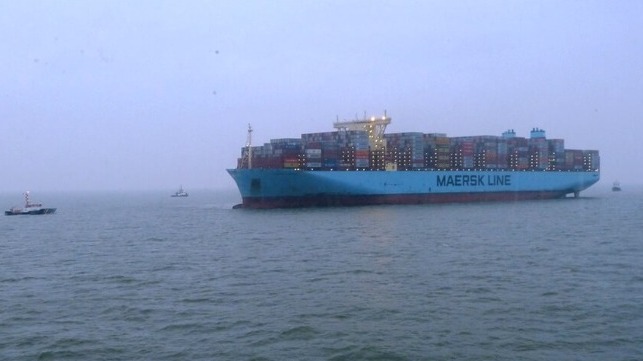Investigation Shows Failed Turn Led to 2022 Grounding of Mumbai Maersk

A year after the grounding of one of Maersk’s largest containerships while it was approaching Bremerhaven, German authorities issued their first summary of the facts leading up to the grounding of the vessel on February 2, 2022, at approximately 23:00. The incident was deemed a serious marine casualty, but they were able to refloat the vessel after 26 hours without any serious damage.
The 214,000 gross ton Mumbai Maersk, which has a carrying capacity of 19,630 TEU, was inbound for Bremerhaven from Rotterdam when the grounding occurred requiring a large-scale salvage operation. Germany’s Federal Bureau of Maritime Casualty Investigation has released the Interim Investigation report outlining the facts of the grounding. They have not reached any conclusion but a series of contributing factors emerge as well as luck that the vessel grounded in a soft area which was a dumping ground for dredged silt removed from the fairway.
The ship had chosen a deep-water route for its approach to Bremerhaven avoiding the coastal route. At the time of the grounding, they determined she was traveling with a draft of 41.9 feet, which while large is below her loaded draft which for example on her current voyage is reported at over 54 feet.
She was on schedule proceeding to her berth at a container terminal in Bremerhaven having already entered the Neue Weser fairway with a pilot aboard when the circumstances started to change. The vessel had been given permission from traffic control to proceed at a speed of 6 to 7 knots along the fairway. Her draft during the passage however made the vessel tide-dependent.
Shortly before reaching a narrow area of the fairway where she would have had limited maneuverability, the vessel was advised that her berth was still occupied, leading to the decision by traffic control to deny her entry to the next section of the fairway. This required her to make a turn to reverse course. She executed the turn but within a half hour was advised the berth was now free and she could proceed into Bremerhaven.
With the tide window threatening to close, the captain and pilot decided to make an immediate turn back to her original course to reach the berth on the current tide. It was this second maneuver that failed with the ship coming out of the south side of the fairway at a speed estimated at almost 10 knots. Due to the sudden deceleration as the bow ran into the soft dredged silt, the ship began a yawing motion. The ship continued to pivot around a longitudinal axis on the grounded foreship taking 20 minutes before it stopped moving. It had rotated by more than 180 degrees from the direction in which it had run onto the dumping ground.
They attempted to refloat her at the next high tide but that first effort failed. Overnight between February 3 and 4, 2022 on the second high tide, they were able to pull her free using brute force from a flotilla of tugs. The ship had also been lightened by 7,000 tons of ballast. A subsequent survey showed only paint abrasion to the hull.
The German authorities reported that they investigated a range of issues including the approach coordination on the Weser, the management of dredge silt, and dredge operations in the area. They have also undertaken an extensive analysis of the navigational maneuvers before the accident. They are currently in the process of preparing the investigation report.
